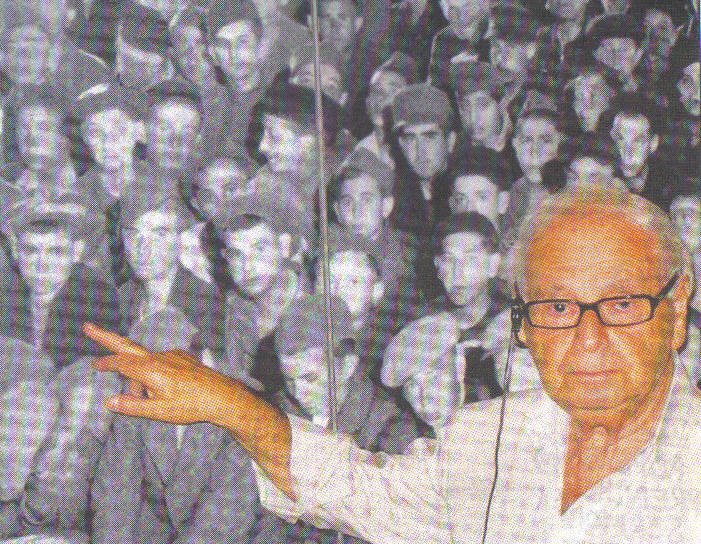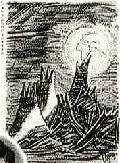
|
Melbourne resident Mr Yossi Beklermaszyn points to a picture of himself taken at the Buchenwald concentration camp one month after liberation in June 1945.
Guides at the Melbourne Holocaust Museum include such survivors and also
others who can point to photos and memorabilia of close relatives on display in the museum.
|
Australian Jews and the Holocaust
|
The Australian Jewish Community has the highest number
of Holocaust survivors in the Diaspora.
There are many personal links to that era.
Within the community there are societies of Children of
the Holocaust, those rare people who managed
to survive as children the dreadful years in Europe.
Because of the make-up of the Australian Jewish community,
the Holocaust looms large.

|
LEO ROSNER 26-6-1918 --10-10-2008
One of many survivors within the Jewish Community of Melbourne was the musician Mr Leo Rosner,
who played mostly on his personalised accordian at so many family
celebrations in Melbourne for over forty years. Almost up to his death in 2008
he was a volunteer guide at the Melbourne Holocaust Museum.
During World War II, Leo and his wife Helen
were among more than 1200 Jews saved from near certain death through being placed on the "list" of employees
of Oscar Schindlers factory. In the epilogue to the film Schindler's List
he can be seen placing a stone on Oscar Schindler's grave in East Jerusalem,
walking stride by stride with the actor who played his role.
Leo died in 2008, aged 90 years, mourned by his wife Helen, his two daughters,
six grandchildren and six great-grandchildren.
|

| Underground School Kovno Ghetto
When the Jewish Community Council of Victoria remembered the Holocaust on Yom Hashoa Day 2009,
it issued flyer announcing the memorial service based on this picture taken in the
underground school in the Kovno Ghetto, in Lithuania.
The theme of the service was "glimmers of hope" and indeed there were.
The teacher in the photo,
Shmuel Rosenthal survived the war -- and though it is believed all the children in the picture were murdered
-- Mr Rosenthal's own daughter, Rona, survived, and is living in Melbourne.
Ron was born in the ghetto
when such births were by Nazi dictates rendered "Illegal", and as a very tiny baby,
was drugged so that she could not scream, wrapped up as a small package, and smuggled
out of the ghetto to a willing aryan foster mother.
Rona, a volunteer guide at Melbourne Holocaust Museum, has two children and two grandchildren, all living in Australia.
Glimmer indeed. One estimate is of 5,400 children in the ghetto, of whom a little more than 200 survived.
An account of two such child survivors is given
here.
References for the Kovno Ghetto are to be found in
this annotated listing.
|
Australian Knowledge of the Holocaust
During WW2 knowledge of the ongoing holocaust in Europe was rather minimal.
Australian troops did not participate in the liberation of Europe in WW2 except in a token, symbolic role.
However it is noteable that Alan Moore, official Australian War Artist was present at the liberation by British troops
of the Bergen Belsen Concentration Camp on 15 April 1945.
|
Australia as a Sanctuary for Holocaust Refugees
At the Evian Conference, July 6-15, 1938, Australia agreed
to accept 15,000
Jewish Refugees. At this date only Germany viewed as refugee source.
On September 3, 1939 World War II starts, and escape became impossible,
so few admitted under this scheme. Nevertheless, the Australian
offer more generous than that of other countries. In total, 1933-1940
8,586 Jewish refugees known to AJWS came. (Excludes the approx 2000
Jewish "enemy aliens" on the Duneera).
In all, Australia, which had before WW2 about 30,000 Jews,
admitted 35,000 jewish migrants from 1938 to 1961. These "New Australians"
comprised a mix
of holocaust survivors, refugees from Arab countries,
and those who had taken temporary refuge in such places as Shanghai.
New Zealand admitted very few Holocaust Refugees
From 1933 to the start of World War II, about 1,000 Jewish refugees from Central Europe settled in New Zealand.
There were negligible numbers of Jewish immigrants in the immediate post-War years.
|
|
RESETTLEMENT OF HOLOCAUST REFUGEES/SURVIVORS BY COUNTRY
|
| Australia | 1933-39 | 7,000 |
| 1940 | 1,500
| | 1945-54 | 17,000 |
| 1954-61 | 10,000 |
| Israel | 1945-48 | 250,000 |
| 1948+ | 150,000 |
| USA | 1945-52 | 80,000 |
| Canada | 1945-48 | 8,000 |
| 1948-55 | 40,000 |
| UK | 1945-55 | 2,000 |
| South Africa | 1945-55 | 1,500 |
| New Zealand | 1933-45 | 1,000 |
| 1945+ | <300 |
|
Notes:-
Australia, with its modest pre-WW2 Jewish population, was a haven for more than 35,000 holocaust
refugees. Only Israel gained a greater percentage of Holocaust survivors.
-
The 1,500 that reached Australia in 1940 were the internees on the Duneera.
-
Historian Dr Ann Beaglehole reported (July 2007) with regard to New Zealand as a haven for holocaust survivors:
"about 120 permits were issued
in the immediate post-war years. About 200 more permits issued by 1948 Ė but not
clear if these were part of NZís displaced personís quota or in addition to it.
- The figure for Israel 1945-48 includes the "illegal immigrants" deported from
"Palestine" to Cyprus by the British; 28,000 of these were held in camps on Cyprus in May 1948.
Release from Cyprus internment was slow especially for men of "military age"
despite the end of the mandate; not until February 1949 were all returned to Israel.
Other Resources
Jewish Holocaust Museum and Research Centre Melbourne
collects oral testimony and also publishes memoirs of the Holocaust.
|

|
here is one story, without a direct Australian link,
of one wonderful child who did not survive,
but whose memory and name lives on in space.
The story of
Peter Ginz, the schoolboy SF artist
of Terezin concentration camp who drew most wondrous views of other worlds.
|
© H. A. Cohen 2010
|




